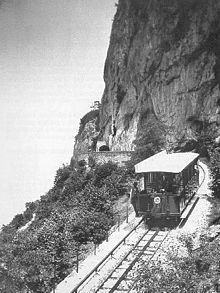Chemin de fer du Salève
The Chemin de fer du Salève was the first electric rack railway in the world. It led to the Mont Salève, located near Geneva , but already on French territory or in the French department of Haute-Savoie ( Upper Savoy) . The full French name was Société anonyme des Chemins de fer du Salève (CFS), German "Aktiengesellschaft der Salève-Eisenbahnen". It was also known under the name Funiculaire du Salève, although it was not a cable car.
The meter-gauge rack railway was equipped with a two-lamellar rack system Abt and drawn the electricity like a subway from a conductor rail , which was located on the side of the running rails. This dangerous power supply, which was maintained during the entire operating period, led to the death of three people and an unknown number of wild animals and farm animals.
Twelve railcars for passenger transport with an empty weight of 10.4 tons, designed for 40 passengers, together with 6 lorries for freight transport, took care of all traffic. The railcars were 8.5 meters long, 2.1 meters wide and 3 meters high. Two engines of 40 HP (29 kW) enabled an operating speed between 5.4 and 10.8 km / h.
The first line Étrembières - Mornex - Monnetier-Mairie - Treize-Arbres (Mont Salève) of 6 km in length was opened in 1892, the second line Veyrier - Monnetier-Mairie of 3 km in length in 1894.
The trains left Etrembières and Veyrier at the same time and met in Monnetier-Mairie. From there they drove in a convoy of individually driven railcars up to 1140 m above sea level. M. located terminus Treize-Arbres.
In the summer of 1914, an ascent or descent took about an hour. The travel costs for a trip from Veyrier to Treize-Arbres and back in 1st class were FF 10 and in 2nd class FF 7.
In the beginning, the Salève railway was profitable. After the First World War, also as a result of the rise in automobile traffic, the cogwheel railway experienced less rosy times. With the opening of the competing cable car Veyrier - Treize-Arbres in 1932, the end of the now outdated and too slow cog railway was sealed. In 1937, operations on the last section were stopped after the villages in the Étrembières - Monnetier-Mairie section had already been opened up by a bus service in the winter of 1931/1932. The entire route was canceled as early as 1938.
Web links
- Salève Railway (French)


